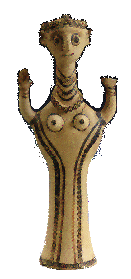Woman the beginning of misfortunes
 Many years after the creation, the gods made Pandora to punish mortals.
She was created of marriageable age and endowed with all the graces of
the heaven, the fascination of the earth and the wealth of the
immortals. In order to serve the purposes of the Olympian gods, however,
Pandora had to be superficial, curious, disobedient, and lacking in
prudence and judgement. This is why she opened the jar containing the
misfortunes that immediately attacked mortals and have been attacking
them ever since.
Many years after the creation, the gods made Pandora to punish mortals.
She was created of marriageable age and endowed with all the graces of
the heaven, the fascination of the earth and the wealth of the
immortals. In order to serve the purposes of the Olympian gods, however,
Pandora had to be superficial, curious, disobedient, and lacking in
prudence and judgement. This is why she opened the jar containing the
misfortunes that immediately attacked mortals and have been attacking
them ever since.
Through this first act of rebellion Pandora, as a sister of Eve, brought
upon herself and her sex the responsibility and guilt for the lost
paradise of the human race.
At the bottom of the box there remained only one consolation: Hope.
Woman the beginning of the universe
In the beginning was the Goddess of All Things, Eurynome, who emerged
naked from Chaos. She found nothing on which her feet could rest,
however, and therefore divided the sea from the sky, dancing alone upon
the waves. Eurynome danced towards the south, and the wind set in motion
behind her caused something new and special to appear, something that
would help the task of creation to begin...




[Français]